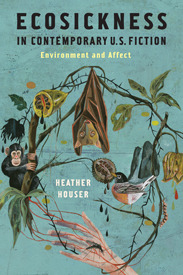 Take a look at your surroundings. Are you sitting in a climate-controlled office next to a window overlooking a sea of traffic? Or are you skimming this article on a porch swing underneath a shady oak tree? Whether you’re surrounded by wide open spaces or a concrete jungle, your environment is significantly affecting your emotional and physical well-being.
Take a look at your surroundings. Are you sitting in a climate-controlled office next to a window overlooking a sea of traffic? Or are you skimming this article on a porch swing underneath a shady oak tree? Whether you’re surrounded by wide open spaces or a concrete jungle, your environment is significantly affecting your emotional and physical well-being.
Authors such as David Foster Wallace and Leslie Marmon Silko have explored this intrinsic bond with the natural world in a genre of fiction called “Ecosickness.” In a new book Ecosickness in Contemporary U.S. Fiction, UT Austin English Professor Heather Houser shows how contemporary American novels and memoirs are developing a new understanding of the connections between ecological damage and physical health.
Read on to learn more about her book and how this new mode of contemporary American fiction is sparking questions about the current state of our environment—and the potential consequences of techno-scientific innovations such as regenerative medicine and alternative ecosystems.
How did you become interested in this particular literary genre?
My initial interest was in 20th-century narratives of disease. As I read a wide range of works on this theme, I began to notice many writers couldn’t talk about disease without also depicting built and non-built environments and ecological issues. I was aware of environmental health memoirs such as Susanne Antonetta’s Body Toxic and Terry Tempest Williams’s Refuge: An Unnatural History of Family and Place, but what I was finding didn’t quite fit this genre. Unlike these books, ecosickness fiction is less interested in determining the causal link between environmental conditions and disease. Instead it imagines how emotions, narrative techniques, and aesthetics bring body and earth into relation. One way I explain this in Ecosickness is by showing how recent U.S. novels and memoirs “medicalize” environmental representation, that is, how they figure space using specialized anatomical and physiological terms, often ones referring to the body in a state of dysfunction. Wallace’s Infinite Jest is a rich site for this representational strategy.

How can people benefit from gaining an awareness of their environmental surroundings?
To put it bluntly, the environment is us; self-awareness and awareness of social, economic, and political structures emerge from environmental awareness. For many, spending time in more natural settings and interacting with animals produce joy and rejuvenate. This is certainly an important benefit of environmental awareness. Yet even if we’d rather be inside playing video games than out swimming in rivers, we’re still embedded in our environments. The state of our surroundings affects our health, where we live, how we get from point A to point B, what we eat, and much more. Just as importantly, the environment is a repository for changing historical and social conditions; it records individuals’ and a culture’s values.
Is there an Ecosickness author in particular who inspires you?
Leslie Marmon Silko’s Almanac of the Dead inspired the ideas for the project, even though it may be the book in Ecosickness I enjoyed reading the least. It’s challenging because of its length, huge cast of characters, loose structure and depictions of violence and depravity. It’s the most overtly political book I examine and imagines a revolution sweeping through the Americas that will destroy capitalism and colonialism and restore and heal lands expropriated from indigenous peoples.
Silko builds anxiety through a number of strategies, above all through scenes in which villainous characters use biotechnologies like genetic manipulation and artificial ecosystems to promote injustice. We might think anxiety is useful for stirring up a population and fomenting revolution; I wondered if this was the case. I asked whether, in the novel, anxiety impinges on the very possibility of revolutionary action the book otherwise advocates. Almanac was so inspiring to my research because it powerfully demonstrates that environmental scholars need to account for the full spectrum of environmental effects and study how those emotions influence our ethical and political orientations.
What do you hope readers will take away from this book?
A crucial takeaway of Ecosickness and my other research is that we can’t comprehend environmental challenges and their ethical dimensions through the languages of science and economics alone. We must call on aesthetic tropes, metaphors, and narratives and the knowledge they produce. Our bodies and emotions are crucial conduits to understanding and responding to environmental change. I emphasize this point in the book’s conclusion, when I describe ecosickness fiction as “an invitation to read its stories out into the world. It opens channels to the talk between policy and psychology, aesthetics and activism, education and ethics, and data and doxa that positive interventions in pervasive sickness demand.”
Could you highlight a particular message in this book that is relevant today?
One of the thrills of studying contemporary culture is that most everything I research is relevant today. But if I had to choose a message that’s most relevant both today and in the day-to-day, it’s that we must approach techno-scientific “fixes” to illness and environmental with respectful skepticism. Ecosickness authors aren’t technophobes or antiscience, and my book doesn’t encourage these positions either. I hit on the idea of respectful skepticism throughout my readings but perhaps most poignantly in the chapter on AIDS memoirs by Jan Zita Grover and Wojnarowicz and how they conceptualize discord. Grover’s and Wojnarowicz’s books show discord to be crucial to the medical politics of AIDS and the environmental politics of land development because it helps us strike a balance between trust in science and skepticism toward it.
Is there anything else you’d like to add?
I hope Ecosickness expands our sense of what counts as “environmental literature.” When I say this is my research area, people often assume I study Henry David Thoreau or Edward Abbey. Yet environmental representation is all around us, not just in works by artists we think of as environmentalist. Those representations shape how we perceive the world off the page and govern our responses to it. Therefore, it’s important to identify unexpected environmental tropes and examine their workings and functions wherever we find them.
